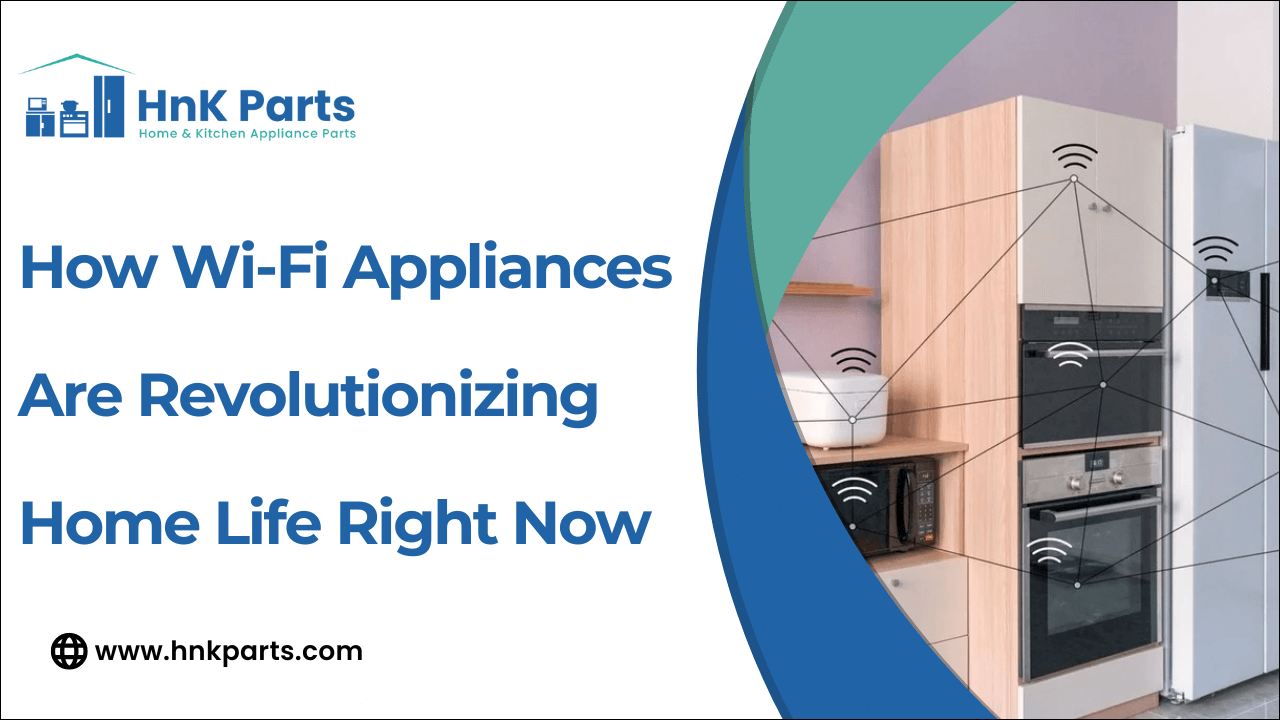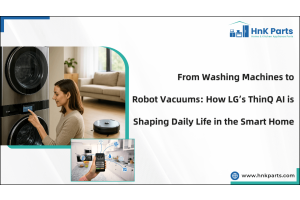
How Wi-Fi Appliances Are Revolutionizing Home Life Right Now
The smart home has rapidly transformed from a futuristic concept to an everyday reality, evolving how we interact with our living spaces. By 2025, Wi-Fi-enabled appliances will have moved beyond novelty, becoming integral components of modern homes, seamlessly woven into the fabric of our daily routines. These intelligent devices offer unprecedented convenience, efficiency, and control, marking a significant shift in how we manage our households.
This blog explores the benefits of remote access, the advantages of energy efficiency, and the proactive nature of maintenance alerts. By understanding both the benefits and the essential security considerations, you'll gain a comprehensive perspective on how Wi-Fi appliances are not just changing but revolutionizing home life as we know it.
What Are Wi-Fi Appliances?
Wi-Fi appliances are traditional household devices enhanced with Wi-Fi connectivity and smart technology. This integration allows them to connect to your home network and be controlled remotely via smartphones, tablets, or voice assistants.
Key components that make this connectivity possible include:
-
Wi-Fi modules: These are the hardware components that enable the appliance to connect to your home's Wi-Fi network. They handle the communication protocols necessary for data exchange.
-
Embedded software: This software allows the appliance to interpret commands, manage its functions, and communicate data back to the user or other devices.
Connection to smart ecosystems
This compatibility allows you to control your appliances using voice commands or through a centralized smart home app.
-
Google Home: With Google Home, you can use voice commands like "Hey Google, preheat the oven to 350 degrees" or create routines that automate multiple tasks, such as turning off all lights and appliances when you leave the house.
-
Amazon Alexa: Similar to Google Home, Alexa enables voice control and automation through routines. You can say, "Alexa, start the dishwasher," or set up routines that trigger actions based on time or other smart devices.
-
Apple HomeKit: HomeKit offers integration through Apple devices, allowing you to control appliances via Siri or the Home app. This ecosystem emphasizes security and privacy, ensuring a secure connection between your devices.
Examples of Wi-Fi Appliances
The range of Wi-Fi-enabled appliances is continually expanding, but here are some of the most common and impactful examples:
-
Stove & oven: Smart stoves and ovens can be preheated remotely, monitored for cooking progress, and even turned off if you forget. Some models offer features like guided cooking, which adjusts temperature and cooking time based on the recipe.
-
Dishwasher: Wi-Fi-enabled dishwashers can be started remotely, monitored for cycle completion, and provide notifications if there are any issues, such as low rinse aid.
-
Refrigerator: Smart refrigerators come with features like inventory tracking, which can help you keep track of what you have on hand, suggest recipes based on available ingredients, and even automatically reorder groceries.
-
Washing machine: Remote start, cycle monitoring, and alerts for when the laundry is done are key features of smart washing machines. Some models can also detect the type of fabric and adjust the wash cycle accordingly.
-
Dryer: Similar to washing machines, smart dryers offer remote start, cycle monitoring, and alerts. They can also detect moisture levels and adjust drying time to prevent over-drying.
-
TV: Smart TVs have been around for a while, but their integration into the broader smart home ecosystem continues to evolve. They offer voice control and streaming services and can be integrated into smart home routines.
Convenience & Remote Access
The convenience of Wi-Fi appliances stems from their ability to be controlled remotely, giving you unprecedented flexibility and control over your home from anywhere in the world.
|
Feature |
Description |
Examples/Use Cases |
|
Control via smartphone/tablet |
|
|
|
Oven control |
|
|
|
Appliance monitoring |
|
|
|
Task scheduling |
|
|
|
Laundry scheduling |
|
|
|
Oven preheating |
|
|
|
Notifications & monitoring |
|
|
|
Maintenance reminders |
|
|
|
Error motifications |
|
|
Energy Efficiency & Cost Savings
Wi-Fi appliances not only offer convenience but also contribute to energy efficiency and cost savings through smart features that optimize energy usage.
Smart scheduling
Schedule your appliances to run during off-peak hours when energy prices are lower, reducing your overall energy costs.
-
How It works: Time-of-Use Rates: Many utility companies offer time-of-use rates, where electricity costs less during off-peak hours.
Appliance scheduling:
Use the scheduling features of your Wi-Fi appliances to run them during these off-peak hours automatically.
-
Example: Set your dishwasher and washing machine to run overnight when electricity rates are lower.
Maintenance Alerts & Diagnostic Features
Wi-Fi appliances come equipped with features that help you maintain them properly, reducing the risk of breakdowns and extending their lifespan. Receive automatic alerts for various maintenance needs, ensuring your appliances are always in top condition.
Types of alerts:
-
Low supplies: Get alerts when you are running low on essential supplies like dishwasher detergent or refrigerator water filters.
-
Filter changes: Receive reminders when it’s time to replace filters in your refrigerator, washing machine, or other appliances.
-
Maintenance needs: Be notified of potential maintenance issues, such as a clogged dryer vent or a buildup of scale in your dishwasher.
Synchronization With Home Security Systems
Integrate your Wi-Fi appliances with your home security system to enhance security and convenience.
-
Appliance monitoring: Monitor your kitchenware appliances remotely to ensure they are not being tampered with.
-
Security alerts: Receive alerts if an appliance is unexpectedly turned on or off, which could indicate a security breach.
-
Lighting control: If your smart washing machine finishes a load of laundry, IFTTT can trigger your smart lights to change color, alerting you that the laundry is done.
-
Climate control: If your smart oven reaches a certain temperature, IFTTT can trigger your smart thermostat to adjust the temperature in your kitchen.
Personalized & Predictive Functionality
Wi-Fi appliances are becoming increasingly intelligent, learning your habits and preferences to provide personalized experiences and predictive functionality.
-
Smart appliances can learn your usage patterns and preferences over time, adapting to your specific needs and routines.
-
Your smart oven learns your preferred cooking temperatures and times for different dishes, automatically suggesting these settings when you start cooking.
-
Your smart washing machine learns your preferred wash cycles for different types of clothing, automatically suggesting these cycles when you load the machine.
AI-Driven Performance Optimization
Artificial intelligence is being integrated into Wi-Fi appliances to optimize their performance and provide intelligent recommendations.
-
Recipe suggestions: Your smart refrigerator analyzes your food inventory and suggests recipes based on available ingredients.
-
Adaptive wash cycles: Your smart washing machine uses sensors to detect the type of fabric and the level of dirtiness, adjusting the wash cycle accordingly to optimize cleaning and energy efficiency.
Future Trends in Wi-Fi Appliances
The world of Wi-Fi appliances is constantly evolving, with exciting trends on the horizon that promise to further enhance the smart home experience.
-
AI integration & predictive maintenance: AI algorithms will analyze appliance data to predict potential maintenance needs, allowing you to schedule repairs before breakdowns occur. AI will provide personalized recommendations based on your usage habits, such as suggesting new recipes or optimizing energy usage.
-
Smart grids & home energy management: Appliances will automatically adjust their energy usage based on grid demand, helping to stabilize the grid and reduce energy costs. Appliances will integrate with home energy storage systems, allowing you to store excess energy from solar panels and use it during peak hours.
-
Sustainability-focused innovations: Appliances will be made from more sustainable and eco-friendly materials. Appliances will be designed to be even more energy-efficient, reducing their environmental impact.
By integrating these smart devices into your home, you can automate your daily routines, reduce energy consumption, and enhance your overall quality of life. As technology continues to advance, the future of Wi-Fi appliances looks brighter than ever, with AI-driven personalization, predictive maintenance, and sustainability-focused innovations on the horizon. Embrace the smart home revolution and stay updated with the latest advancements in Wi-Fi appliances to make your home smarter, more efficient, and more enjoyable. HnKParts is your trusted online store for high-quality home appliance parts in the USA. We offer a wide range of Stove & Oven Parts, Dishwasher Parts, Refrigerator Parts, Washing Machine Parts, and Dryer Parts to keep your appliances running smoothly.
FAQs
Can Wi-Fi appliances work without internet access?
Most Wi-Fi appliances require an internet connection to enable remote control and cloud-based features. However, many still offer basic manual or offline functions even without the internet.
Do Wi-Fi appliances require frequent software updates?
Yes, manufacturers release updates to enhance functionality, fix bugs, and improve security. Enabling automatic updates or checking via the appliance’s app ensures optimal performance.











